Yukgaejang is a hearty, spicy beef soup made with shredded beef, lots of scallions and other vegetables. Perfect soup for cold days ahead!

Yukgaejang (육개장) is a hearty, spicy beef soup that’s highly popular in Korea. Made with shredded beef, lots of scallions (pa, 파) and other vegetables such as gosari (fernbrake fiddleheads), beansprouts, and mushrooms, this is a substantial soup that has a great depth of flavor.
You won’t need anything other than a bowl of rice for a completely satisfying meal on a cold winter day. In Korea, yukgaejang is also popular as nourishing soup that helps fight the summer heat.
As we do with many Korean soups, we often enjoy this soup with some rice mixed in. Some people prefer to keep the rice and soup separately while eating. What’s your preference?
Which cut of beef to use
Beef brisket (yangjimeori, 양지머리) is the typical cut for this soup and many other Korean soups. It’s a flavorful, tough cut of meat that’s great for making broth. When properly boiled, the meat turns pull-apart tender, making it ideal for this soup. You can also use flank steak (chimasal, 치마살) or shank meat (satae, 사태).
If chicken is used instead, the soup is then called dakgaejang (닭개장).

Vegetables
If you want to use only one vegetable for this soup, it should be scallions. Lots of them! After the beef, this is the most important ingredient for this soup. In Korea, the large variety green onions, called daepa (대파), are used for soups. No, they are not the same as leeks. Daepa is packed with unique sweet oniony flavor. It really elevates the tastes of soups!
Luckily, daepa now is available at Korean markets around here, especially during fall and winter.
There are other similar beef soups in Korea, but gosari (fernbrake fiddleheads) is unique in this soup. You can buy dried gosari (고사리) at any Korean market and rehydrateby a combination of soaking and boiling in water. Look for the ones with short, thin stems.
Besides adding soft, chewy texture to the dish, gosari imparts a deep, earthy flavor to the soup. A bag of dried gosari can last for a long time in your pantry, and you can also use to make gosari namul side dish, which is great in bibimbap(비빔밥).

Seasoning
Sesame oil is essential, and it’s typically infused with gochugaru (Korean red chili pepper flakes) for a chili oil effect. Simply heat the oil and mix with the gochugaru. For added layers of flavor, I usually add very small amounts of gochujang (Korean red chili pepper paste) and doenjang (Korean fermented soybean paste). But, absolutely optional! This yukgaejang recipe is not fiery hot. Adjust the heat level according to your taste.
Variations
If you want your soup to be extra rich, you can also boil some beef bones (such as neck bones) with the meat. Or, I sometimes add some pre-made seolleongtang broth (aka milky bone broth or sagol yuksu) to boil the meat because I usually have some in my freezer. You can also use store-bought milky beef bone broth, which is usually labeled as sagol yuksu (사골육수) or sagol gomtang (사골곰탕).
You can also use anchovy broth or dashima broth to boil the beef to add extra flavors to the resulting broth.
I usually drizzle lightly beaten eggs over the soup at the end of cooking. Some people prefer thin egg omelette garnish (jidan, 지단). You can skip the eggs if you want.
Noodles are also a great addition! Dangmyeon (당면), sweet potato starch noodles (aka japchae noodles), is typical for this soup.
Instant Pot yukgaejang
Lately, I’ve been using my Instant Pot to make this dish. It really is much quicker to cook a tough cut of meat, and I love how tender and moist the beef turns out.
Simply add the meat, onion, and optional radish to the Instant Pot along with water. You will need much less water because it doesn’t evaporate in the Instant Pot. I use about 10 cups for this recipe.
Then, cook on Manual High for 30 minutes. When it’s done cooking, release the pressure after 10 minutes. Remove the meat, and strain the broth. Follow the rest of the recipe, and use the Sauté function to finish up.
More soup recipes
For more Korean cooking inspirations, follow along on YouTube, Pinterest, Twitter, Facebook, and Instagram.

Ingredients
- 1 ounce dried gosari, 고사리 (fernbrakes) - about 1 cup rehydrated
- 1 pound beef brisket, 양지머리 (or flank steak or shank meat)
- 1/2 onion (do not cut off the stem)
- 8 ounces Korean radish (mu, 무), cut into big chunks - optional
- 8 ounces bean sprouts (sukju, 숙주)
- 3 dry shiitake mushrooms, soaked (or 2 ounces fresh shiitake or oyster mushrooms)
- 2 - 3 bunches scallions (or 2 or 3 stalks of Korean daepa (large variety scallion) 2 or 3 stalks of Korean daepa (large variety scallion)
Seasonings
- 2 tablespoons sesame oil
- 2 tablespoons gochugaru, 고추가루 (red chili pepper flakes) - 2.5 to 3 TB for spicier soup
- 1 tablespoon minced garlic
- 2 tablespoons guk ganjang, 국간장 (soup soy sauce), divided
- 1 teaspoon gochujang, 고추장 (red chili pepper paste) - optional
- 1 teaspoon doenjang, 된장 (soybean paste) - optional
- salt and pepper
Optional additions
- 2 eggs lightly beaten
- 3 ounces dangmyeon (당면), starch noodles soaked in warm water for 20 minutes
Instructions
- Add the gosari and 4 cups of water to a small pot. Boil over medium heat, covered, until tender. Mine only took about 30 minutes, but the time can vary significantly depending on gosari. Turn the heat off and let it cool in the cooking water. When ready to use, rinse in cold water and drain. Cut into 4-inch lengths, removing tough ends of the stems, if any. (See note 1.)
- In a large pot, bring the meat, onion, and optional radish, to a boil in 14 cups of water (see note 2 for other broth options). Reduce the heat to medium, and skim off the scum. Boil, covered, until the meat is tender enough for shredding, about 1 hour. Pull a string of meat off and check the tenderness. Let the meat cool a bit in the cooking liquid. Discard the vegetables, reserving the stock in the pot. Spoon off any visible fat. The broth should be about 7 to 8 cups.
- When the meat is cool enough to handle, shred into about 3 to 4-inch strips.
- Add the meat, gosari, mushrooms, 1 tablespoon soup soy sauce, and garlic to the pan. Toss well to coat everything with the oiled chili pepper flakes.
- Add the meat and gosari mixture to the broth. Stir in 1 tablespoon of soup soy sauce, optional gochujang and doenjang, and boil over medium high heat, covered, for about 10 minutes.
- Throw in the bean sprouts and scallions, and boil over medium heat for another 10 minutes. Add salt (1 teaspoon or more) and pepper to taste. Within a few minutes before turning the heat, add the optional noodles. Slowly drizzle the optional eggs over the boiling soup and turn the heat off. Serve with rice.
Instant Pot method
- Add the meat, onion, and optional radish to the Instant Pot along with 10 cups of water.
- Cook on Manual High for 30 minutes. When it's done cooking, release the pressure after 10 minutes. Remove the meat, and strain the broth. Follow the rest of the stove top recipe. Use the Sauté function for steps 7 and 8 to finish up.
Notes
- You can also soak the gosari for several hours to soften and then boil over medium heat until tender.
- You can use a combination of milky beef bone broth and water if you want. Add 4 to 6 cups or more. And simply reduce water by the same amount. You can also boil the beef in dashima broth or anchovy broth to add another layer of flavor to the soup.
This recipe was originally posted in December 2014. I’ve updated it here with new photos, more information and minor improvements to the recipe.































